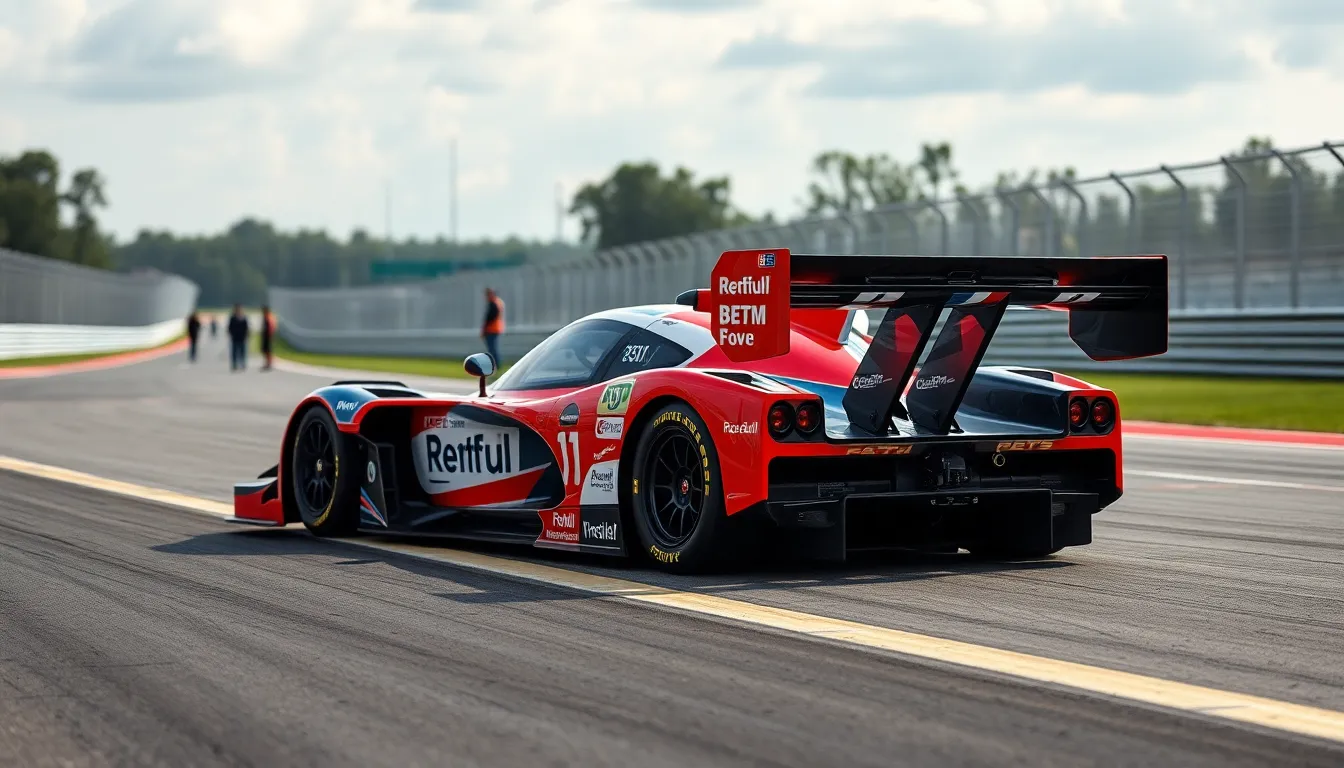Table of Contents
ToggleIn the high-speed world of motorsports, downforce isn’t just a fancy term; it’s the unsung hero that keeps cars glued to the track. Imagine trying to balance a stack of pancakes while riding a rollercoaster—that’s what racing is like without proper downforce. It’s all about maximizing grip and minimizing the risk of flying off into the grandstands.
Understanding Downforce Optimization
Downforce optimization is fundamental in enhancing vehicle performance. It directly affects grip, speed, and cornering stability.
Definition of Downforce
Downforce refers to the aerodynamic force that pushes a vehicle downward as it moves forward. Engineers design components like wings and diffusers to maximize this effect, enhancing traction on the track. Increased downforce leads to better tire contact with the road, crucial for high-speed maneuvers. The relationship between speed and downforce isn’t linear; as speed increases, the downforce force rises exponentially. Understanding this concept is vital for optimizing race car design.
Importance in Motorsport
Downforce plays a pivotal role in motorsport, impacting the overall competitiveness of a vehicle. Maintaining high-speed stability becomes easier with optimized downforce levels. Without adequate downforce, cars become prone to losing grip during turns, risking spins and accidents. Additionally, effective downforce contributes to quicker lap times, as drivers can maneuver more aggressively. Teams fine-tune aerodynamics to harness downforce efficiently, providing a competitive edge. Significant shifts in performance can arise from small adjustments in aerodynamic elements.
Techniques for Downforce Optimization

Downforce optimization involves various techniques that enhance vehicle performance in motorsports. These methods focus on maximizing grip and stability on the track.
Aerodynamic Design
Aerodynamic design plays a crucial role in downforce optimization. Engineers analyze airflow over vehicle surfaces to create shapes that generate downforce. Components like front and rear wings are designed to manage air pressure effectively. Designing these elements requires understanding the balance between drag and downforce. Adjusting angles and profiles can create significant changes in performance. Computational fluid dynamics simulations help visualize airflow, guiding design decisions. Efficient aerodynamic design leads to improved high-speed stability and cornering ability.
Vehicle Suspension Tuning
Vehicle suspension tuning is essential for maximizing downforce effectiveness. When engineers adjust spring rates and damping, they enhance the connection between tires and the track. Proper tuning allows for better load distribution on tires during acceleration and braking. This connection increases tire grip, essential for maintaining downforce. Optimized suspension settings help vehicles adapt to various track conditions. Engineers also consider ride height, as it impacts airflow and aerodynamics. Balancing suspension dynamics with downforce elevates overall vehicle performance.
Tools and Software for Downforce Analysis
Various tools and software facilitate downforce analysis, enhancing vehicle design and performance.
Computational Fluid Dynamics (CFD)
Computational Fluid Dynamics (CFD) plays a crucial role in downforce optimization. This software simulates airflow around vehicle surfaces, allowing engineers to visualize patterns and identify areas of improvement. Utilizing CFD, teams can modify wing shapes and angles to maximize downforce while minimizing drag. High-resolution simulations can model airflow at different speeds, providing insightful data that supports design decisions. It streamlines the development process by testing multiple configurations quickly, saving both time and resources. Advanced CFD tools can even predict how changes will influence lap times, offering a competitive advantage.
Wind Tunnel Testing
Wind tunnel testing remains a vital method for assessing downforce generation accurately. Engineers create scale models of race cars to examine how aerodynamic components perform in controlled environments. Using a wind tunnel, teams measure the forces acting on each component, making adjustments to optimize airflow and enhance downforce. Data gathered from these tests provides detailed insights into real-world performance and informs potential design alterations. Effective wind tunnel testing complements CFD results, validating simulations through empirical observations. This dual approach ensures engineers achieve the best possible aerodynamic performance in racing applications.
Case Studies in Downforce Optimization
Downforce optimization showcases practical applications and outcomes in motorsport. Various teams have undertaken innovative strategies leading to remarkable successes.
Successful Implementations in Racing
In Formula 1, team innovations transform downforce dynamics. Mercedes optimized their front wings to enhance airflow and increase grip, contributing to multiple championship wins. Likewise, Red Bull Racing utilizes a unique rear wing design to balance downforce and drag effectively, significantly improving lap times. Successful use of adjustable aerodynamic elements allows drivers to adapt to changing track conditions. These implementations illustrate that refined aerodynamics directly boosts performance and competitiveness in challenging environments.
Lessons Learned from Failures
Failures in downforce optimization also provide valuable insights. In 2019, a prominent team faced challenges due to an overly aggressive wing design, resulting in increased drag and lower straight-line speeds. These miscalculations led to a considerable drop in their competitive edge. Another example involved a team that neglected suspension adjustments while enhancing downforce, causing instability in high-speed corners. These setbacks highlight the need for a balanced approach, where downforce developments consider drag implications and overall vehicle dynamics. Understanding these lessons enables teams to refine their strategies continuously.
Future Trends in Downforce Optimization
Downforce optimization is set to experience significant advancements in the coming years. The integration of cutting-edge technologies and predictive analytics will reshape the landscape of motorsport aerodynamics.
Advances in Technology
Computational fluid dynamics continues to evolve, offering enhanced simulations for real-time adjustments. New software tools provide engineers with more detailed airflow analysis, improving design accuracy. Additionally, advances in lightweight materials enhance aerodynamic components, leading to improved performance without excessive weight. Smart sensors embedded in vehicles monitor downforce levels live, allowing for on-the-fly adjustments during races. Combining data from various sources will allow teams to maximize downforce and minimize drag more effectively than ever before.
Predictions for Motorsport Evolution
Future motorsport vehicles are likely to feature adaptive aerodynamics, which adjusts wing angles based on speed and cornering forces. This capability enhances downforce dynamically, optimizing performance under varying track conditions. Increased collaboration between engineers and data scientists will result in faster iterations of design and testing, driving innovation further. Enhanced understanding of driver behavior through telemetry data might influence downforce strategies, tailoring setups to individual driving styles. Overall, a shift toward fully integrated systems promises to make downforce optimization more precise and responsive in competitive racing environments.
Downforce optimization stands as a pivotal factor in the realm of motorsports. By mastering aerodynamic design and suspension tuning, teams can achieve remarkable improvements in vehicle performance. The balance between downforce and drag is crucial for maximizing grip and stability on the track.
As technology evolves, the future of downforce optimization looks promising. The integration of advanced tools like CFD and wind tunnel testing will continue to refine designs. Moreover, adaptive aerodynamics and real-time monitoring will revolutionize how teams approach racing strategies.
Ultimately, a focused commitment to downforce optimization not only enhances lap times but also fosters a competitive edge in the high-stakes world of motorsport.




